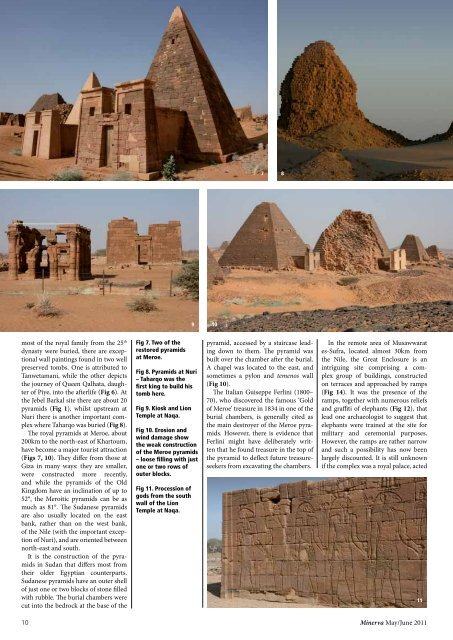Cult of beauty - Minerva
Cult of beauty - Minerva
Cult of beauty - Minerva
You also want an ePaper? Increase the reach of your titles
YUMPU automatically turns print PDFs into web optimized ePapers that Google loves.
most <strong>of</strong> the royal family from the 25 th<br />
dynasty were buried, there are exceptional<br />
wall paintings found in two well<br />
preserved tombs. One is attributed to<br />
Tanwetamani, while the other depicts<br />
the journey <strong>of</strong> Queen Qalhata, daughter<br />
<strong>of</strong> Piye, into the afterlife (Fig 6). At<br />
the Jebel Barkal site there are about 20<br />
pyramids (Fig 1), whilst upstream at<br />
Nuri there is another important complex<br />
where Taharqo was buried (Fig 8).<br />
The royal pyramids at Meroe, about<br />
200km to the north-east <strong>of</strong> Khartoum,<br />
have become a major tourist attraction<br />
(Figs 7, 10). They differ from those at<br />
Giza in many ways: they are smaller,<br />
were constructed more recently,<br />
and while the pyramids <strong>of</strong> the Old<br />
Kingdom have an inclination <strong>of</strong> up to<br />
52°, the Meroitic pyramids can be as<br />
much as 81°. The Sudanese pyramids<br />
are also usually located on the east<br />
bank, rather than on the west bank,<br />
<strong>of</strong> the Nile (with the important exception<br />
<strong>of</strong> Nuri), and are oriented between<br />
north-east and south.<br />
It is the construction <strong>of</strong> the pyramids<br />
in Sudan that differs most from<br />
their older Egyptian counterparts.<br />
Sudanese pyramids have an outer shell<br />
<strong>of</strong> just one or two blocks <strong>of</strong> stone filled<br />
with rubble. The burial chambers were<br />
cut into the bedrock at the base <strong>of</strong> the<br />
10<br />
Fig 7. Two <strong>of</strong> the<br />
restored pyramids<br />
at Meroe.<br />
Fig 8. Pyramids at Nuri<br />
– Taharqo was the<br />
first king to build his<br />
tomb here.<br />
Fig 9. Kiosk and Lion<br />
Temple at Naqa.<br />
Fig 10. Erosion and<br />
wind damage show<br />
the weak construction<br />
<strong>of</strong> the Meroe pyramids<br />
– loose filling with just<br />
one or two rows <strong>of</strong><br />
outer blocks.<br />
Fig 11. Procession <strong>of</strong><br />
gods from the south<br />
wall <strong>of</strong> the Lion<br />
Temple at Naqa.<br />
9<br />
10<br />
pyramid, accessed by a staircase leading<br />
down to them. The pyramid was<br />
built over the chamber after the burial.<br />
A chapel was located to the east, and<br />
sometimes a pylon and temenos wall<br />
(Fig 10).<br />
The Italian Guiseppe Ferlini (1800–<br />
70), who discovered the famous ‘Gold<br />
<strong>of</strong> Meroe’ treasure in 1834 in one <strong>of</strong> the<br />
burial chambers, is generally cited as<br />
the main destroyer <strong>of</strong> the Meroe pyramids.<br />
However, there is evidence that<br />
Ferlini might have deliberately written<br />
that he found treasure in the top <strong>of</strong><br />
the pyramid to deflect future treasureseekers<br />
from excavating the chambers.<br />
7<br />
8<br />
In the remote area <strong>of</strong> Musawwarat<br />
es-Sufra, located almost 30km from<br />
the Nile, the Great Enclosure is an<br />
intriguing site comprising a complex<br />
group <strong>of</strong> buildings, constructed<br />
on terraces and approached by ramps<br />
(Fig 14). It was the presence <strong>of</strong> the<br />
ramps, together with numerous reliefs<br />
and graffiti <strong>of</strong> elephants (Fig 12), that<br />
lead one archaeologist to suggest that<br />
elephants were trained at the site for<br />
military and ceremonial purposes.<br />
However, the ramps are rather narrow<br />
and such a possibility has now been<br />
largely discounted. It is still unknown<br />
if the complex was a royal palace, acted<br />
11<br />
<strong>Minerva</strong> May/June 2011

















